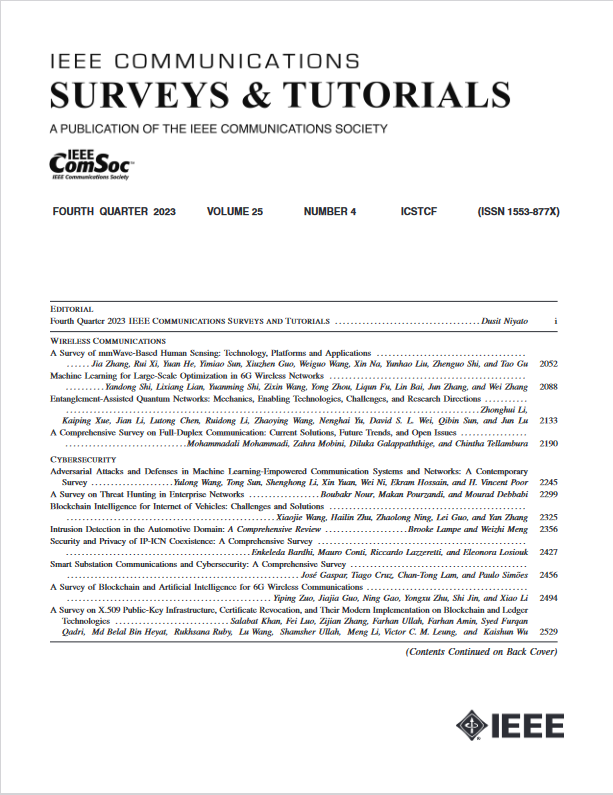Networking Architecture and Key Supporting Technologies for Human Digital Twin in Personalized Healthcare: A Comprehensive Survey
IF 34.4
1区 计算机科学
Q1 COMPUTER SCIENCE, INFORMATION SYSTEMS
引用次数: 0
Abstract
Digital twin (DT), referring to a promising technique to digitally and accurately represent actual physical entities, has attracted explosive interests from both academia and industry. One typical advantage of DT is that it can be used to not only virtually replicate a system’s detailed operations but also analyze the current condition, predict the future behavior, and refine the control optimization. Although DT has been widely implemented in various fields, such as smart manufacturing and transportation, its conventional paradigm is limited to embody non-living entities, e.g., robots and vehicles. When adopted in human-centric systems, a novel concept, called human digital twin (HDT) has thus been proposed. Particularly, HDT allows in silico representation of individual human body with the ability to dynamically reflect molecular status, physiological status, emotional and psychological status, as well as lifestyle evolutions. These prompt the expected application of HDT in personalized healthcare (PH), which can facilitate the remote monitoring, diagnosis, prescription, surgery and rehabilitation, and hence significantly alleviate the heavy burden on the traditional healthcare system. However, despite the large potential, HDT faces substantial research challenges in different aspects, and becomes an increasingly popular topic recently. In this survey, with a specific focus on the networking architecture and key technologies for HDT in PH applications, we first discuss the differences between HDT and the conventional DTs, followed by the universal framework and essential functions of HDT. We then analyze its design requirements and challenges in PH applications. After that, we provide an overview of the networking architecture of HDT, including data acquisition layer, data communication layer, computation layer, data management layer and data analysis and decision making layer. Besides reviewing the key technologies for implementing such networking architecture in detail, we conclude this survey by presenting future research directions of HDT.个性化医疗中的人类数字双胞胎的网络架构和关键支持技术:全面调查
数字孪生(DT)指的是以数字方式准确呈现实际物理实体的一种前景广阔的技术,已引起学术界和工业界的极大兴趣。数字孪生的一个典型优势是,它不仅可以用来虚拟复制系统的详细操作,还可以分析当前状况、预测未来行为并完善控制优化。虽然 DT 已在智能制造和交通等多个领域得到广泛应用,但其传统范例仅限于体现非生命实体,如机器人和车辆。因此,在以人为中心的系统中采用数字孪生时,人们提出了一个新概念,即人类数字孪生(HDT)。特别是,HDT 可以对人体个体进行硅表示,能够动态反映分子状态、生理状态、情绪和心理状态以及生活方式的演变。这些都促使人们期待 HDT 在个性化医疗保健(PH)中的应用,它可以促进远程监测、诊断、处方、手术和康复,从而大大减轻传统医疗保健系统的沉重负担。然而,尽管潜力巨大,HDT 在不同方面都面临着巨大的研究挑战,近年来已成为一个日益热门的话题。在本研究中,我们首先讨论了 HDT 与传统 DT 的区别,然后介绍了 HDT 的通用框架和基本功能。然后,我们分析 HDT 在 PH 应用中的设计要求和挑战。随后,我们概述了 HDT 的网络架构,包括数据采集层、数据通信层、计算层、数据管理层和数据分析与决策层。除了详细回顾实现此类网络架构的关键技术外,我们还介绍了 HDT 的未来研究方向,以此作为本调查报告的结尾。
本文章由计算机程序翻译,如有差异,请以英文原文为准。
求助全文
约1分钟内获得全文
求助全文
来源期刊

IEEE Communications Surveys and Tutorials
COMPUTER SCIENCE, INFORMATION SYSTEMS-TELECOMMUNICATIONS
CiteScore
80.20
自引率
2.50%
发文量
84
审稿时长
6 months
期刊介绍:
IEEE Communications Surveys & Tutorials is an online journal published by the IEEE Communications Society for tutorials and surveys covering all aspects of the communications field. Telecommunications technology is progressing at a rapid pace, and the IEEE Communications Society is committed to providing researchers and other professionals the information and tools to stay abreast. IEEE Communications Surveys and Tutorials focuses on integrating and adding understanding to the existing literature on communications, putting results in context. Whether searching for in-depth information about a familiar area or an introduction into a new area, IEEE Communications Surveys & Tutorials aims to be the premier source of peer-reviewed, comprehensive tutorials and surveys, and pointers to further sources. IEEE Communications Surveys & Tutorials publishes only articles exclusively written for IEEE Communications Surveys & Tutorials and go through a rigorous review process before their publication in the quarterly issues.
A tutorial article in the IEEE Communications Surveys & Tutorials should be designed to help the reader to become familiar with and learn something specific about a chosen topic. In contrast, the term survey, as applied here, is defined to mean a survey of the literature. A survey article in IEEE Communications Surveys & Tutorials should provide a comprehensive review of developments in a selected area, covering its development from its inception to its current state and beyond, and illustrating its development through liberal citations from the literature. Both tutorials and surveys should be tutorial in nature and should be written in a style comprehensible to readers outside the specialty of the article.
 求助内容:
求助内容: 应助结果提醒方式:
应助结果提醒方式:


